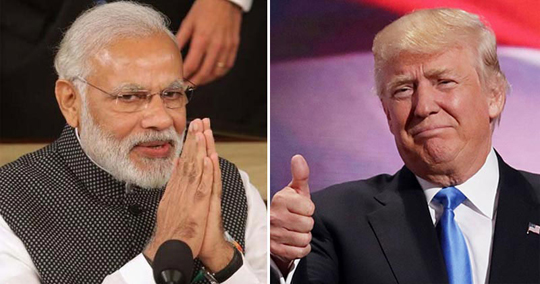Washington, Apr 29: The first hundred days of the Trump administration have shown a positive trend for the Indo-US relationship and the upward trajectory of ties was expected to continue with bipartisan support for it, a former top Indian diplomat has said. On the eve of US President Donald Trump completing 100 days in office, former Indian Ambassador to the US Arun Singh said the Indo–US relationship during this period has broadly proceeded along expected lines.

"As the engagement of the past hundred days has shown, India is clearly seen as an important interlocutor, with some convergence of interest, and potential for an even stronger mutually beneficial partnership," he told PTI. Beginning in the last phase of the Bush administration and almost all but two years of the Obama administration, Singh was a key player in driving the Indo-US relationship in the last one decade.
During the campaign, President Trump had spoken positively about India and expressed support for consolidating the Indo-US relationship further. Trump has spoken several times on phone with Prime Minister Modi, Singh said. India's National Security Adviser Ajit Doval and Foreign Secretary S Jaishankar have had consultations with senior US officials during their visits this year, he noted. US National Security Adviser Lt Gen H R McMaster recently visited India and also called on the Prime Minister.
Finance Minister Arun Jaitley met with US Treasury and Commerce Secretaries earlier this month in Washington, Singh said, referring to the high-level bilateral visits. "We can expect the positive trajectory to continue since there is now bipartisan support in the US for the relationship," Singh said. At the same time, he said acknowledged that there will "no doubt" be some areas of concern. "The eventual US decision on H-1B visas will have consequences for our technology workers and companies. Reduction in US tax rates, if realised, could draw capital into the US and away from other countries," he warned.
"Large US deficit, on account of tax reduction and infrastructure spending, could raise interest rates globally, which would also have consequences for India," the former Indian diplomat said. Responding to a question on Trump's foreign policy in the first 100 days of his administration, Singh, who retired from the foreign service late last year, said 100 days is perhaps too short, and certainly an artificial, 24/7 news cycle driven timeline, to assess the enduring and defining parameters of the foreign policy of any new administration.
"This initial phase is also usually marked by tension between the compulsions ofproposals made during the campaign aimed at rousing the base and getting out the vote, and the constraints subsequently imposed by limits of power and realisation of larger consequences," he said. These hundred days have thus seen the fulfilment of some campaign promises, reversals on others, and several critical issues still being evaluated, Singh noted. Trump was sworn in as the 45th President of the United States on January 20 and completes hundred days in office today.
"As promised in the campaign, President Trump has taken the US out of TPP (Trans Pacific Partnership), convinced Canada and Mexico to agree to a renegotiation of NAFTA (North America Free Trade Agreement), and initiated the process of potential action against steel and aluminium imports into the US. There has also been some focus on dealing with ISIS," Singh said.
On the other hand, unlike the pre-election threats, China has not been declared a currency manipulator, no additional tariffs have been imposed on imports from China, and Chinese President Xi Jinping was lavishly welcomed in April at what is now being described as the 'southern White House' at Mar-a- Lago in Florida, he noted.
"The two agreed to come up with a 100-day plan to address the major trade imbalance. China is also being described as an important interlocutor for addressing the North Korean nuclear and missile challenge," he said. On April 6, Trump authorised missile strikes on a Syrian airbase, using Presidential prerogative under the US Constitution.
"Earlier he had repeatedly called upon his predecessor not to do so, and to consult US Congress before any such action," Singh said. Relations with Russia have not been improved, he observed, adding that attempts to do so immediately have become controversial in view of the raging controversy about alleged Russian intervention in the US elections to benefit Trump.
"This will now be further complicated by the missile strikes in an area where Russian forces were also present, although Russia had been given some prior notice," he said. "President Trump has, similarly, now spoken of strongly supporting NATO, which he had earlier described as obsolete. He has now referred to sharing vital security interests with allies, while continuing to complain about alliance commitments, and asking allies to contribute more," the former Indian Ambassador said. During his illustrious foreign service career, Singh also served as India's ambassador to Israel and France apart from the US.
He said, on Afghanistan, policy options were being studied by the Trump administration. US National Security Adviser had recently visited Afghanistan, Pakistan and India for discussions, Singh said, noting that the outcome of the current more strident approach to North Korea remains to be seen.
"The Administration is also constrained at the moment because a large number of posts in the Departments of State and Defence, as well as in the National Security Council, still remain to be filled," he said.
The decision making process has so far been White House centric, and the attempt has been to project a robust, muscular approach based on America's strengths, including military, and less on projection of 'American values' or 'soft power', he opined.





Comments
Add new comment